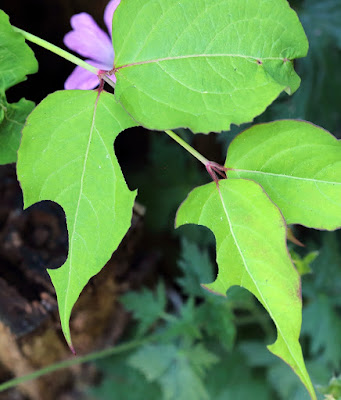In 2016 I noticed a new species of bee in the garden. This was Anthidium manicatum - the European Wool Carder Bee...
Wool carder bees are members of the Megachilidae family and are so called because they collect plant or animal hair or fibers. Leaf-cutter bees also belong in this family, and that's what I spotted in the garden for the first time a few days ago. Megachile centuncularis: the patchwork leaf-cutter bee is the one I think has been busy building two nests. The first clues that they had taken up residence were these leaves with circle shapes cut out of them...
They seem to be particularly fond of the Akebia quinata (Chocolate Vine) but have attacked a few different plant leaves. One nest is at the base of a potted plant...
And the other in a broken clay pot hanging from the bird feeder...
Both nests have two entrances. Or perhaps, an entrance and exit? Not sure, I had better check that. What amazes me is the speed at which they cut and remove a section of leaf: I estimate that it takes on average just 10 seconds. Fascinating too how they roll the section of leaf to enable them to carry it between their legs.
And a tiny video from my phone (may not show in email version of update)
Some information about these bees from the Wildlife Trust that may be of interest to you:
The patchwork leaf-cutter bee is one of a number of small, solitary leaf-cutter bees. Leaf-cutter bees nest in holes in plant stems, dead wood, cliffs or old walls, and can be seen in gardens. They famously cut discs out of leaves, gluing them together with saliva in order to build the 'cells' in which their larvae live. The larvae hatch and develop, pupating in autumn and hibernating over winter. The patchwork leaf-cutter bee is on the wing from April to August, and feeds solely on pollen and nectar.








2 comments:
Stunning images and footage, and so good to have it all happening in the garden too!
I love the wool carder bees, but don't see them all that often really!
Yes, I am so privileged to have so much bug activity in the garden considering how small it is.
Post a Comment